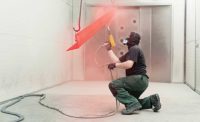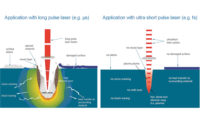Custom metal fabricator Miller Welding & Machine Co. has experienced steady growth since its founding in 1963. The keys to this growth are implementing process control, creating high-quality products and always being open to using new technology.
Founders David Miller, and his brother Lawrence and wife Sara, successfully emphasized these three factors, with the formula working just as well for their successors. Initially, the company occupied only a 2,400-square-foot garage. Today, it operates three large facilities in western Pennsylvania—Sandy Lick, Maplevale and Homer City—that, combined, exceed 500,000 square feet.
Miller Welding’s capabilities have also expanded over the years to include machining, finishing and mechanical assembly. The company regularly produces large and heavy metal fabrications that are complex in shape and difficult to process.
In 2014, Miller Welding needed to more quickly powder coat its large metal parts to keep up with demand. After some research, the company replaced its existing system with two ColorMax systems from Nordson Corp.
Each system was custom built to accommodate larger-than-usual part openings, and it has a production capacity of 22,000 cubic feet per minute. Changing powder color takes roughly 13 to15 minutes, which is a little bit longer than normal, but still fast considering the large size of the systems. Herr Industrial, based in Lititz, PA, provided the process equipment for both systems.
Color changes are performed in an Encore HD Excel feed center, and the film-build thickness requirement ranges from 2 to 6 mils, depending on the part being coated. Line speed is 4 feet per minute.
System one accommodates two robots that are fitted with dual automatic Encore HD guns. System two features 12 automatic guns on two oscillators with in/out positioners, and two Encore LT manual guns.
All of the guns are fed from an Encore powder feed center. The guns apply higher volumes of powder at a lower velocity than a conventional venturi pump, making them ideal for robot systems. Additionally, because of the low velocity, the gun-to-part distance is greatly reduced.
Simply by changing the gun angle and reprogramming the robot, Miller Welding has cut the overall cycle time in half when compared to the original robot program developed at startup. In fact, the powder coating systems coat so quickly that parts are coated faster than they can be unloaded.
Miller Welding runs two shifts per day, five days per week. The company requires five to 10 color changes per shift, and about 30 color changes overall.
During production, all parts to be coated are moved on a power-and-free conveyor through an eight-wheel auto blaster and a five-stage washer. The parts then go through a dry-off oven before entering the ColorMax systems for powder coating. Afterwards, the parts cure in one of two gas convection ovens.
“Part identification is done through a bar code reader,” says Kenny Lindermuth, operations executive at Miller Welding. “It allows us to know where the part is located in the process line at any given time.”
John Binder, global marketing manager at Nordson Corp., points out that each Miller Welding employee has full knowledge about the powder-coating production processes and equipment within the facility. As a result, “[all] processes run like clockwork and every step is meticulously monitored,” says Binder.
For more information on powder coating technologies, call 800-433-9319 or visit www.nordson.com/powder.



